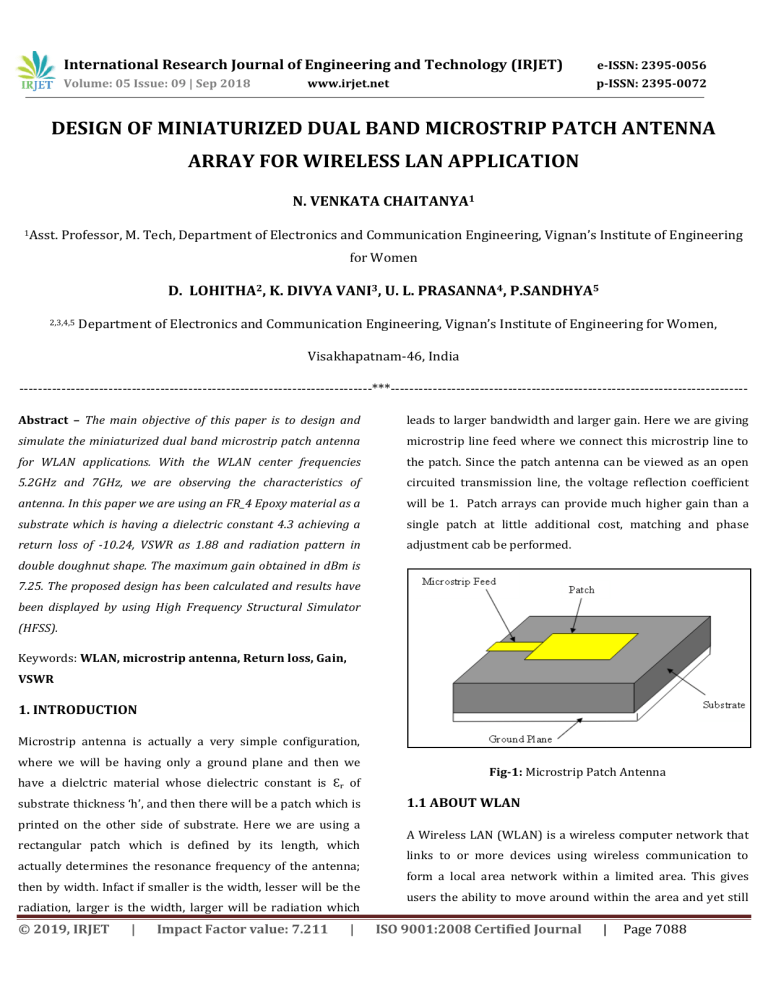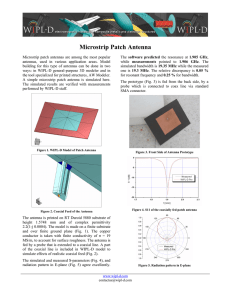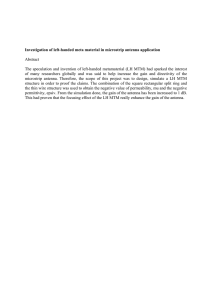IRJET-Design of Miniaturized Dual Band Microstrip Patch Antenna Array for Wireless Lan Application
advertisement

International Research Journal of Engineering and Technology (IRJET) e-ISSN: 2395-0056 Volume: 05 Issue: 09 | Sep 2018 p-ISSN: 2395-0072 www.irjet.net DESIGN OF MINIATURIZED DUAL BAND MICROSTRIP PATCH ANTENNA ARRAY FOR WIRELESS LAN APPLICATION N. VENKATA CHAITANYA1 1Asst. Professor, M. Tech, Department of Electronics and Communication Engineering, Vignan’s Institute of Engineering for Women D. LOHITHA2, K. DIVYA VANI3, U. L. PRASANNA4, P.SANDHYA5 2,3,4,5 Department of Electronics and Communication Engineering, Vignan’s Institute of Engineering for Women, Visakhapatnam-46, India ---------------------------------------------------------------------------***---------------------------------------------------------------------------Abstract – The main objective of this paper is to design and leads to larger bandwidth and larger gain. Here we are giving simulate the miniaturized dual band microstrip patch antenna microstrip line feed where we connect this microstrip line to for WLAN applications. With the WLAN center frequencies the patch. Since the patch antenna can be viewed as an open 5.2GHz and 7GHz, we are observing the characteristics of circuited transmission line, the voltage reflection coefficient antenna. In this paper we are using an FR_4 Epoxy material as a will be 1. Patch arrays can provide much higher gain than a substrate which is having a dielectric constant 4.3 achieving a single patch at little additional cost, matching and phase return loss of -10.24, VSWR as 1.88 and radiation pattern in adjustment cab be performed. double doughnut shape. The maximum gain obtained in dBm is 7.25. The proposed design has been calculated and results have been displayed by using High Frequency Structural Simulator (HFSS). Keywords: WLAN, microstrip antenna, Return loss, Gain, VSWR 1. INTRODUCTION Microstrip antenna is actually a very simple configuration, where we will be having only a ground plane and then we have a dielctric material whose dielectric constant is Ԑᵣ of substrate thickness ‘h’, and then there will be a patch which is printed on the other side of substrate. Here we are using a rectangular patch which is defined by its length, which actually determines the resonance frequency of the antenna; then by width. Infact if smaller is the width, lesser will be the radiation, larger is the width, larger will be radiation which © 2019, IRJET | Impact Factor value: 7.211 | Fig-1: Microstrip Patch Antenna 1.1 ABOUT WLAN A Wireless LAN (WLAN) is a wireless computer network that links to or more devices using wireless communication to form a local area network within a limited area. This gives users the ability to move around within the area and yet still ISO 9001:2008 Certified Journal | Page 7088 International Research Journal of Engineering and Technology (IRJET) e-ISSN: 2395-0056 Volume: 05 Issue: 09 | Sep 2018 p-ISSN: 2395-0072 www.irjet.net be connected to the network. Most modern WLANs are based Step3- Calculation of Effective dielectric constant- on IEEE 802.11 standards and are marked under the Wi-Fi brand name. Users can access the internet from WLAN hotspots in restaurants, hotels and now with portable devices that connect to 3G or 4G networks. Often times this types of public access points require no registration or password to join a network. Others can be accessed once registration has 1 r 1 h e r 1 12 2 2 W 1 2 h= thickness of substrate Step4- Calculation of Effective length- occurred and/or a fee is paid. Leff 1.1 MICROSTRIP ANTENNA IN WLAN Modern implementations of WLANs range from small inhome networks to large, campus sized ones to completely mobile networks on aeroplanes and trains. One need to have an antenna to access the internet from WLAN and hence we need to use small size, low cost, light weight antenna for the extensive use of WLAN which is none other than microstrip antenna. A wireless LAN is ideal for certain work environment and can boost work efficiently levels in most cases. WLAN based spacecraft a receiving antenna with superior rejection to multipath signals is required. Multipath arises when the WLAN transmitted signal takes different paths to the receiving antenna. WLAN uses radio frequencies to transmit c 2 f 0 eff Step5- Calculation of the length extension- W 0.3 0.264 h L 0.412h W eff 0.258 h 0.8 eff Step6- Calculation of resonant frequency1 m 2 n 2 2 f0 2 e L W c and receive data over air. The radiating patch and the feed e = Effective dielectric constant lines are usually etched on dielectric substrate. Table-1: Dimensions for dual patch MSA 2. DESIGN EUQATION PARAMETERS LENGTH(in mm) The design antenna with FR-4 substrate is having the Length of patch 1 3.36 dielectric constant 4.3 Width of patch 1 4.105 Step1: Calculation of the width (w)- Length of patch 2 3.36/2 Width of patch 2 4.105/2 Length of edgefeed 1 1.8 Width of edgefeed 1 0.783 Length of feedline 1 2.007 Width of feedline 1 0.304 W 2 f0 c r 1 2 Step2: Calculation of actual length of the patch- L Leff 2L © 2019, IRJET | Impact Factor value: 7.211 | ISO 9001:2008 Certified Journal | Page 7089 International Research Journal of Engineering and Technology (IRJET) e-ISSN: 2395-0056 Volume: 05 Issue: 09 | Sep 2018 p-ISSN: 2395-0072 www.irjet.net 3. SIMULATED RESULTS After simulation the return loss, gain, voltage standing wave ratios are calculated. Fig-4: S11 parameter of single patch MSA Fig-2: Design of single patch MSA Fig-5: S11 parameter of dual patch MSA 3.2 VOLTAGE STANDING WAVE RATIO Voltage standing wave ratio (VSWR) is a measurement that describes the impedance matching of the antenna to the ratio Fig: 3 Design of double patch MSA or transmission line connected to it. 3.1 S PARAMETER The electrical networks are characterized by S parameter are scattering parameter using matched impedances. In practice the most commonly quoted parameters in regards to antenna is S11. S11 represents how much power is reflected from antenna. Hence S11 is known as reflection coefficient of return loss. If S11=0 dB then all the power is reflected from the antenna. Fig-6: VSWR of single patch MSA © 2019, IRJET | Impact Factor value: 7.211 | ISO 9001:2008 Certified Journal | Page 7090 International Research Journal of Engineering and Technology (IRJET) e-ISSN: 2395-0056 Volume: 05 Issue: 09 | Sep 2018 p-ISSN: 2395-0072 www.irjet.net Fig-10: Gain of dual patch MSA : 7.25 Fig-7: VSWR of dual patch MSA 3.3 Gain Gain is the conversion of input power into radio waves in a particular directional Fig-11: Gain of dual patch MSA: 5.30 The different characteristics of antenna having different patches are shown above. The gain of single patch MSA is observed to be 3.35dBm where as the gain of dual patch MSA is 7.25dBm. A wireless LAN is ideal for certain work Fig-8: Gain of single patch MSA: 3.35 environment and can boost work efficiently levels in most cases. WLAN based spacecraft a receiving antenna with superior rejection to multipath signals is required. Table-2 : Summary Results Parameters Fig-9: Gain of single patch MSA: 2.20 © 2019, IRJET | Impact Factor value: 7.211 | For single For dual patch patch MSA MSA Return loss -30.82dB -34.05dB VSWR 1.56 1.88 Gain(in dB) 3.35 7.25 Substrate FR4 FR4 ISO 9001:2008 Certified Journal | Page 7091 International Research Journal of Engineering and Technology (IRJET) e-ISSN: 2395-0056 Volume: 05 Issue: 09 | Sep 2018 p-ISSN: 2395-0072 www.irjet.net 4. CONCLUSION This paper represents the design and analysis of dual band Microstrip patch antenna at resonant frequencies of 5.2GHz [7] Khodabakhshi H., Cheldavi A. Irradiation of a sixlayered spherical model of human head in the near field and 7GHz. The simulation is done by using HFSS. The VSWR of a half-wave dipole antenna. IEEE Trans. Microw. should be in the range of 1-2 for good performance of the Theory antenna. We obtained VSWR of 1.88 and achieved a gain of 10.1109/TMTT.2010.2040410. 7.25dB and return loss of-10.24. The two designed antennas have a higher gain and a favourable transmission characteristic in the operating band, which is in accordance Tech. 2010;58:680–690. [8] Wang Z., Lee L.Z., Psychoudakis D., Volakis J.L. Embroidered multiband body-worn antenna for with the requirements of WLAN communication under more GSM/PCS/WLAN communications. IEEE Trans. complicated conditions. Antennas Propag. 2014;62:3321–3329. doi: 10.1109/TAP.2014.2314311. 5. REFERENCES [1] Ka Ming Mak ; Hau Wah Lai; Kwai Man Luk; Chi Hou Chan, "Circularly Polarized Patch Antenna for Future 5G Mobile Phones," in Access, IEEE,vol.2, no., pp.15211529, 2014. [2] Antenna Theory, C.Balanis, Wiley, 2nd edition (1997), Chapter 14.ISBN 0- 471-59268-4. [3] Asrokin, A.Rahim, M.K.A. Aziz, M.Z.A.A."Dual band microstrip antenna for wireless LAN application," Applied Electromagnetics,2005. APACE 2005. AsiaPacific Conference on, vol., no., pp.4 pp., 20-21 Dec. 2005 [4] Y. Cao, C. Lu, and Y. Zhang, “A compact dual band miniaturized antenna for WLAN operation,” in Proc. ICMMT, Apr. 2008, pp. 416–419. [5] Richards, W.F., S.E. Davidson, and S.A. Long, “Dual band reactively loaded microstrip antenna, ”IEEE Trans. Ant. Prop., Vol. AP-33,No.5,556-561,1985. [6]. D.M.Pozar, “Microstrip antenna aperture-coupled to a microstrip line,” Electron. Lett., vol.21,no.2,pp.49-50. © 2019, IRJET | Impact Factor value: 7.211 | ISO 9001:2008 Certified Journal | Page 7092 doi:

